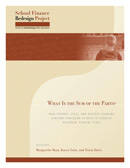This report demonstrates in greater detail than ever before how America’s methods of school finance work against a single-minded focus on student learning. It shows that each level of government has its own priorities about school spending. In schools, the rules for use of funds on one level of government conflict with the rules and priorities established by other levels. The federal government regulates the use of its own funds, assuming that states and localities fund basic school programs. However, many states and localities spend less of their own money on schools that receive federal funds. Thus, schools serving the most disadvantaged students often have less money, and are more constrained about how they use it, than schools serving the advantaged. For example, in this report Roza shows how Texas allocates the money it controls to counter the federal government’s intention to ensure that schools serving children in poverty get extra funding.




